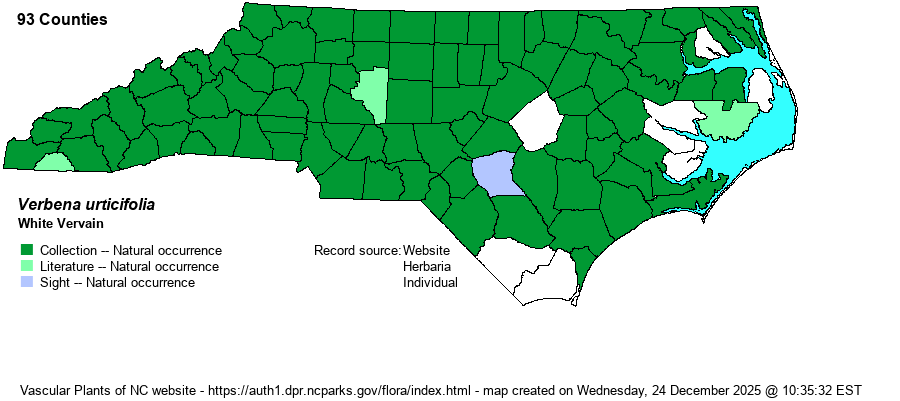| Author | L. | |
| Distribution | Present essentially statewide, though perhaps absent from a few coastal counties.
This is a very widespread species in the Eastern and Central states, ranging from eastern Canada south to central FL and central TX.
| |
| Abundance | Frequent to common in the Mountains, Piedmont, and most of the Coastal Plain. Generally uncommon near the coast, with local absences. This is, by far, the most frequently encountered species in the genus in NC. | |
| Habitat | This species has a great array of habitats, mostly where mesic to rather moist, though it is not a wetland plant. It grows mostly in partial shade, of wooded openings (bottomlands to mesic forests), forest borders, roadbanks, powerline clearings, moist meadows, and other similar sites. | |
| Phenology | Blooms from May to November, and fruits soon after flowering. | |
| Identification | This is a tall and somewhat slender herb, growing to 4-5 feet tall, quite similar to the scarce and coastal V. scabra in appearance, though somewhat larger in most proportions. It may have some branches in the upper part of the stem. The stem has scattered pairs of opposite leaves, each lanceolate in shape, about 4-6 inches long and 2 inches wide, with serrated margins, a tapered tip, and very short petiole. In this species, the upper surface of a leaf is relatively smooth to slightly hairy; V. scabra has a very rough upper surface, with the feel of sandpaper. Both species have numerous long and slender spikes from upper branches, in this species averaging about 6 inches long, very slender, often somewhat curved, and not strictly erect but some just ascending. In this species, the tiny flowers are always white, whereas in V. scabra they are pink to lavender. Although each of these two species is quite tall and striking, the very slender spikes and small flowers can make the plants at times hard to spot at a distance, especially as only a handful of flowers are in bloom on the long spikes at any given time. This species seldom grows in "stands" or colonies, but usually as scattered individuals, though thankfully it is quite widespread and not hard to find in most areas of the state. | |
| Taxonomic Comments | None
| |
| Other Common Name(s) | None | |
| State Rank | S5 | |
| Global Rank | G5 | |
| State Status | | |
| US Status | | |
| USACE-agcp | FAC link |
| USACE-emp | FAC link |

